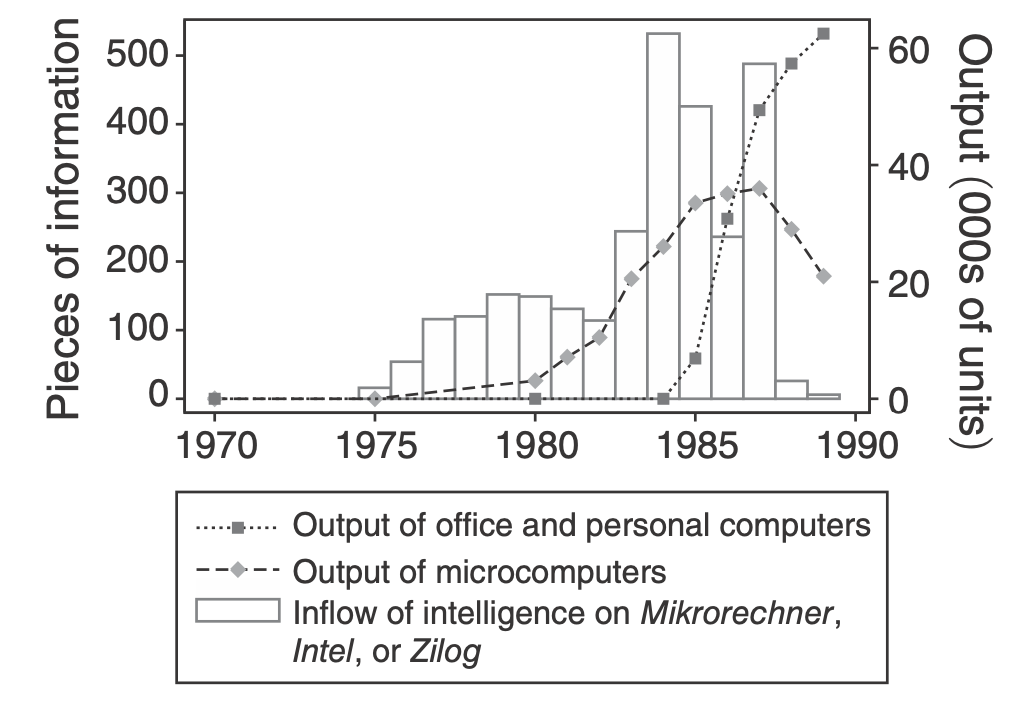The benefits of industrial espionage…are large
Let’s talk about industrial espionage. No, we are not looking at China because I would never dare to accuse China of something as base as industrial espionage. These are honorable people who managed to grow their productivity much faster than any of their BRIC peers over the last 40 years simply because of the superiority of their political system, their hard labour and the ingenuity of their engineers and scientists. Chinese productivity has even grown faster than India’s though India sent its students to the United States and the best schools in the West to develop its human capital. No, China is just so much better at innovation than India, Russia or Brazil.
Productivity growth in BRIC countries

Source: Penn World Tables.
Instead, we are going to talk about industrial espionage performed by the German Democratic Republic during the Cold War. A great study by Albrecht Glitz and Erik Meyersson searched the Stasi Archives in Germany for evidence of industrial espionage and tried to link it to innovation and production in the Eastern part of Germany.
As you might imagine the prime target for industrial espionage was modern technology, which in the 1970s and 1980s were microprocessors and personal computers. The bars in the chart below show the transmission of information gained through industrial espionage in the West to the East. The lines show the annual production of microprocessors and computers in East Germany. It is clearly visible how the intelligence gained through espionage boosts production.
East German espionage in microprocessor technology

Glitz and Meyersson (2020).
East Germany never became a known hub for computer hardware, but it takes little imagination how China is boosting its productivity in high-tech areas through industrial espionage. Sorry, I meant to say how China could boost its productivity if it engaged in industrial espionage.
Productivity in East Germany at least was boosted dramatically through the intelligence gained by espionage. Glitz and Meyersson calculate the counterfactual factor productivity in the German Democratic Republic if it hadn’t benefitted from espionage and compared it to the realized development. Relative to West Germany, the East could boost its productivity dramatically. By the end of the Cold War, East Germany’s productivity would have been 13.3 percentage points lower had they not engaged in espionage. Meanwhile, China managed to grow its factor productivity relative to the United States by 13% in the ten years from 2001 to 2011 before productivity growth started to slow. So, China is clearly more innovative because it managed to get the same boost in just ten years that the GDR got from 17 years of espionage.
Productivity in East Germany with and without espionage

Source: Glitz and Meyersson (2020).
However, it seems likely to me that industrial espionage is still practiced today to gain an unfair competitive advantage or close the productivity gap between industrial and developing nations. It is a so far ignored challenge for free trade agreements and the WTO that industrial espionage largely goes unpunished. But we need to find ways to discipline criminal actors, and no trade war is not the answer. As the current crisis shows all too clearly, breaking up global supply chains is devastating for industrialised countries. Instead, we need to give the WTO more teeth in its ability to punish bad actors and make sure that countries that ignore WTO rulings or engage in industrial espionage need to feel some pain. This could be brought about by targeted embargoes or the withholding of developmental aid, which often ends up in the coffers of the local elites anyway.



